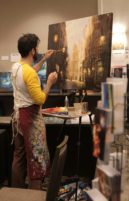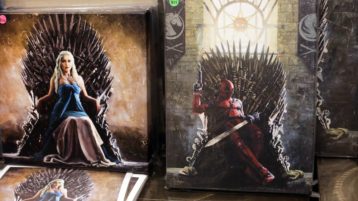
A young woman gasps excitedly. “It’s a giant painting of Snape!”
Across the room, a boy pulls his mother in the direction of a Black Panther painting. Some people stroll around in Hogwarts robes. It was encouraged, after all. “We welcome all witches and wizards,” the advertisements proclaimed, “Muggles will be tolerated.”
Paintings featuring everyone from Jon Snow to Gandalf to Wonder Woman to Han Solo line the walls, canvas prints of various sizes stacked next to paper versions. Hopeful fans can pick up a painting of Daenerys on the Iron Throne—or Deadpool, because, you know, why not? Prices range everywhere from $5 greeting cards up to several thousand dollars for the original works.
For the weekend, the second-floor gallery space of the Hilton Hotel in Boston’s Back Bay has been taken over by The Incredible Art Gallery from Denver, Colorado. The gallery has recently started taking their show on the road with pop culture art events like this one, visiting a new city every month or so. Their last stop was Portland, Oregon. Up next is Phoenix, Arizona.
The show features a handful of different artists. Heather Theurer, a licensed Disney artist, has several pieces. So does Kat Tatz, whose Alice in Wonderland pieces could perhaps be described as Lewis Carroll by way of Salvador Dalí. There are a few works by Star Wars parody artist who works under the pseudonym “Bucket.”
The majority of the space, however, is filled by the work of Christopher Clark. A self-educated oil painter, he’s a licensed Marvel and Lucasfilm artist. In 2017, he was Lucasfilm’s featured artist at their annual Star Wars Celebration, and 2018 was his third year as Lucasfilm and Marvel’s featured artist at San Diego Comic Con. The artist himself is here, the main attraction, present to sign purchases and embellish prints with unique painted touches, a perk available for any canvas print bought at an event like this one (unlike the originals, embellishments are done with acrylics—oil paints would take too long to dry.) He paints, he signs, he thanks people for coming, poses for pictures. Conversations with customers range in subject from his artistic training and inspirations to the plot holes of The Crimes of Grindelwald.
His pop culture art depicts fantastical worlds, but Clark relies on classical techniques. He uses real-life references whenever he can—visiting Diagon Alley at the Universal Orlando “Wizarding World of Harry Potter” to take reference photos, hiring cosplayers to model for characters in costume. “That’s, I think, why my paintings have a level of authenticity,” he says, “because I paint from real life things.”
Clark is a proud Hufflepuff, a Hufflepuff badge pinned on the paint-covered smock he wears over a Hufflepuff shirt. When a customer approaches his table to get a print signed wearing Hufflepuff gear, Clark shows his house pride (“A Hufflepuff! Yeah, right on!”). His jacket has Boba Fett patches on it. He agrees with the consensus that The Empire Strikes Back is the best Star Wars film, and of the newer entries, he professes admiration for Rogue One. He’s watched the infamous Holiday Special—“as much of it as I could stand.” Regarding Game of Thrones, he’s Team Daenerys and hopes that Jon Snow won’t get in the way too much.
As an artist, Clark would like one day to be known first and foremost for his original artwork, but he is genuinely a fan of the popular culture he paints. That’s why you won’t find any Doctor Who lying around—he has not gotten around to watching the show yet. In addition to a steady stream of painting work, events like these keep him busy. When someone from The Incredible Gallery runs out to get lunch, he requests something he can eat with one hand, as he usually does at these events. He’s skilled at the art of eating while painting, and he doesn’t want to keep the line waiting.
Clark’s pop culture art started with Lord of the Rings. He’s a fan of the books, but it was watching the Peter Jackson film trilogy that inspired him to feature Middle Earth in his art. “When you watch the movies, they’re so beautifully shot, and they have these beautiful landscapes and scenes in them. Sometimes when I’d watch them, I would just pause the movie and look at it and go, ‘oh, this is gorgeous,'” he says. “I’m like, ‘I should just paint that, that’s a beautiful scene.'” One of the first pop culture paintings he made was “Sam and Frodo’s Journey”—”it’s this beautiful landscape that just happens to have Sam and Frodo in it.” A fusion of the fine art he loves and popular culture he enjoys, he made a whole series of Lord of the Rings paintings.
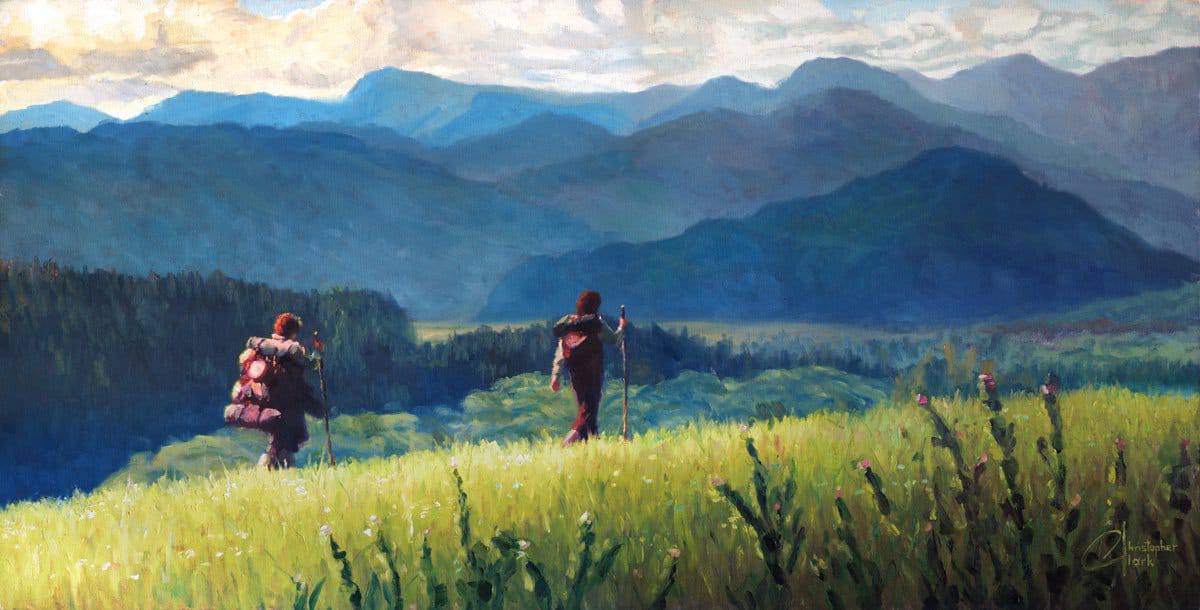
“Sam and Frodo’s Journey”
These paintings caught the attention of Jared Rosen, the Art Director of The Incredible Art Gallery. The gallery started as a traditional fine art gallery, but they realized that demands were shifting. “People weren’t gravitating any more towards these traditional cottage paintings or nice sunset paintings, and we had a high demand for pop culture artwork,” Rosen says, “so we shifted gears.” Included in “shifting gears” was bringing in Clark, whom they quickly got signed with Lucasfilm and Marvel. Rosen admits that pop culture art is not his personal favorite, but it gets people enthusiastic about fine art and supporting individual artists, which, as far as he’s concerned, is the most important thing.
Being a licensed artist comes with definite perks, but also restrictions. Clark has the freedom to come up with his ideas—so long as they stick to canon and get the publisher’s approval. The finished paintings also have to be approved, which can occasionally lead to something of a headache in the form of revisions. One of the more intense overhalls, for example, involved “Not a Jedi Yet,” a painting depicting the lightsaber battle between Darth Vader and Luke Skywalker at the end of Empire Strikes Back. Clark painted their stances like the ones seen in the movie, but Lucasfilm wanted to see more of Vader’s face and have his elbow raised higher. Clark had to reconfigure the pose “without making it too awkward or weird-looking,” which was tough.
Lucasfilm also had some concerns about Clark’s largest painting to date, “Confronting Vader,” an 8-foot-tall portrait of Darth Vader—namely, that in it Vader is around 7′ tall, several inches taller than his canon height of 6′ 8″. “So they shortened the limited edition print of that piece to a 7′ tall painting,” he laments. “I wanted him to be bigger than life.” Unfortunately, the powers that be did not.
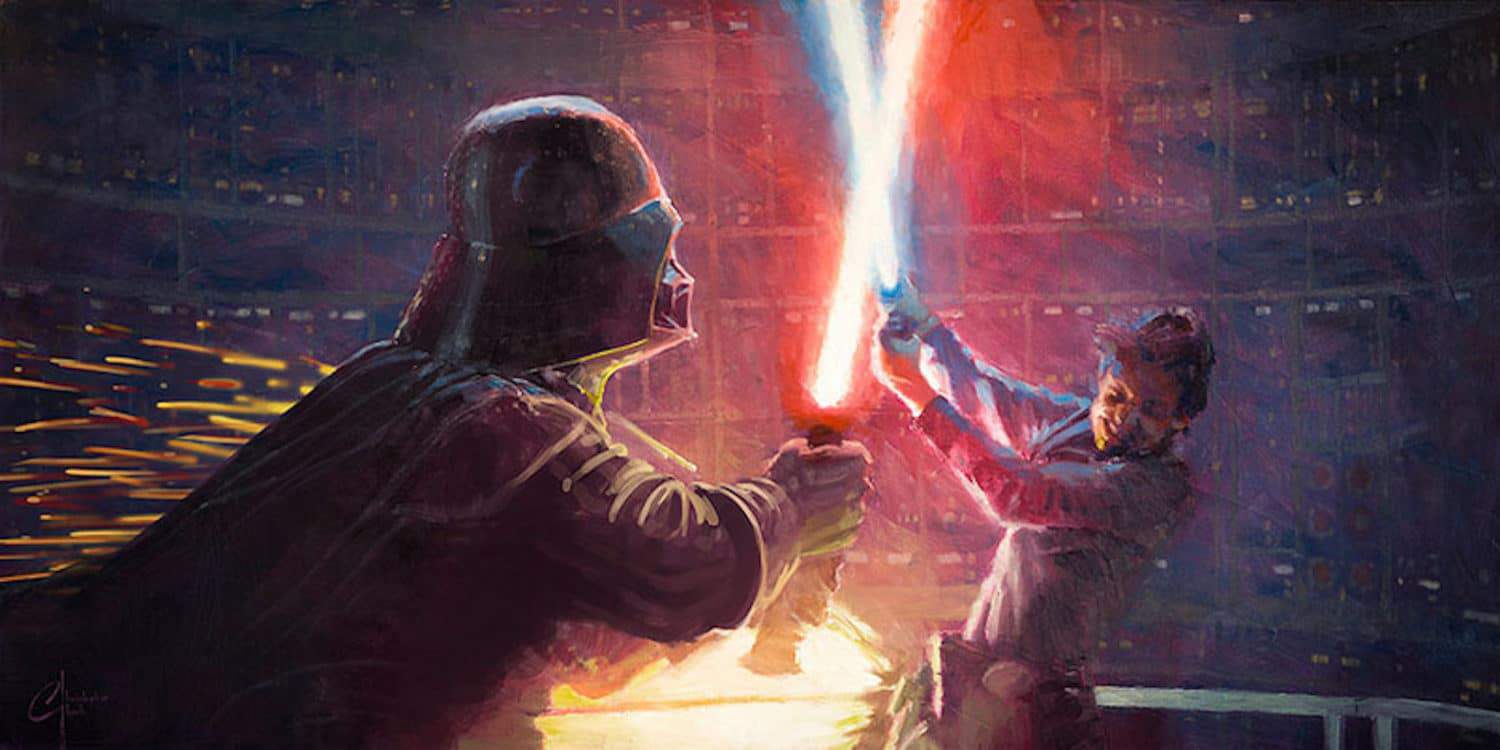
“Not a Jedi Yet”
Another interesting quirk of being a licensed Lucasfilm artist is that even though the company is now owned by Disney, George Lucas still has first rights of refusal on all Star Wars originals. In other words, Clark has to offer all his Star Wars paintings to Lucas and have Lucas turn them down before being allowed to sell them to anyone else. It’s written in the contract.
To date, Lucas has purchased two of Clark’s paintings—”Master Yoda,” a portrait of Yoda, and somewhat shockingly, “TIE Fighter Sunset,” a painting of the scene in The Force Awakens when the heroes look to the sky and see the First Order arriving, an homage to the famous helicopter sunset shot in Francis Ford Coppola’s Apocalypse Now. “Apparently, [Lucas] never buys anything that’s not the original trilogy or the prequels,” Clark comments, his painting being the lone exception. “I thought that was kind of an honor.”
While paintings like “TIE Fighter Sunset,” “Not a Jedi Yet,” and “Sam and Frodo’s Journey” all have a relatively direct basis in particular shots from their respective films, he doesn’t always get that lucky. “Sometimes I have to compose the whole thing from scratch,” he says, bringing up the example of “Attack on Takodana,” which depicts the entirety of the 10-minute battle sequence at Maz Kanata’s castle in a single painting.
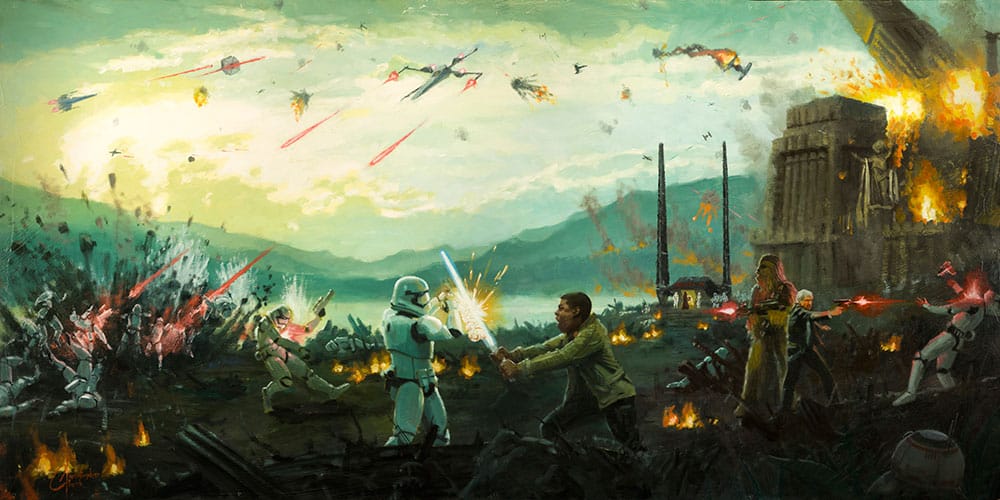
“Attack on Takodana”
We’ve already discussed some of Clark’s preferences as a fan, so I ask him about his preferences as an artist. “Light is really my favorite thing to paint,” he says, speculating that this might contribute to his admiration for his favorite pop culture works. “So many of these things that I love, the light is so gorgeous in them.”
Metallic things are tricky to paint because “they reflect so many colors and there are so many color changes and subtle things that happen.” He brings up a recent painting he did of the scene from A New Hope where the heroes play holo-chess, “Let the Wookie Win.” “C-3PO was such a pain in the ass to paint,” he says. Beyond the reflective qualities of metal, the perfectly straight lines and tiny details of robots don’t exactly pair naturally with oil painting. “Anything really techy and shiny and metallic, it gets that much more tricky to paint authentically.” That the neurotic protocol droid would prove the most finicky character to paint somehow seems only fitting.
Pop culture portraits, Clark adds, also present a special challenge because there is no margin for error when dealing with actor likeness. “It has to be 100 percent correct or people don’t like it.”
Clark’s work runs the gamut from the Westeros to Wonderland, but what really sells? Judging from the steady presence of the checkout line, the answer seems to be “everything,” but the artist notes that there are definite trends. When I ask him what’s most popular right now, he doesn’t hesitate. “Harry Potter and Alice in Wonderland,” he says. “For sure.” Harry Potter, he notes, is consistently at the top of the list. “People love Harry Potter. The fandom is unreal.”
Alice also has “ravenous” fans. Among all fandoms, Clark notes, Alice is unique in that he doesn’t have to stick to a particular canon, which he appreciates as an artist, as it allows him space to truly make it his own. “This world exists, and this sort of mythos foundation exists, and you can kind of pull from that and make your own variations and people are cool with that,” he says. “It gives me a ton of freedom to really create and do whatever I want with the story and the characters and have a lot of fun with it. With all these other fandoms people get really sticky over the canon. But Alice, no one cares. Like, ‘this is Alice, I don’t care what it is, it’s just awesome.'”
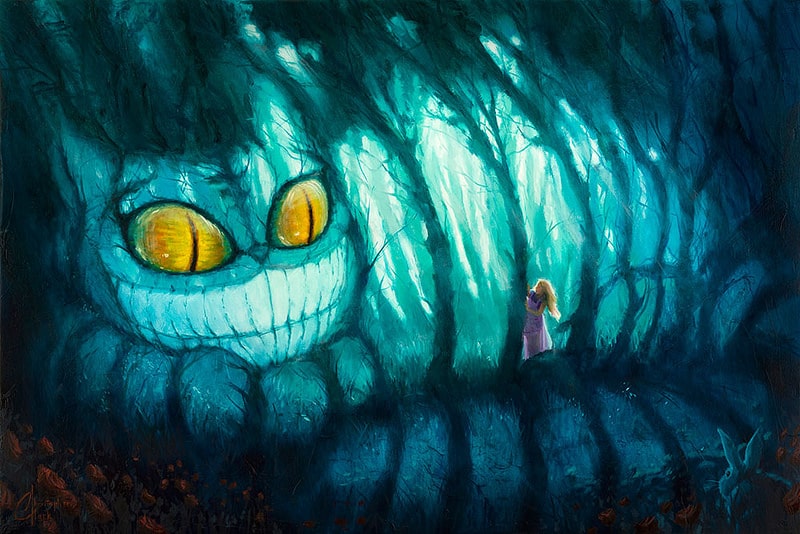
“Cheshire Woods”
I mention that I’m somewhat surprised he didn’t name Marvel or Star Wars as top sellers considering how Jedi and superheroes seem to be dominating practically every other facet of popular culture. Clark thinks that may just be the problem. “They’re kind of oversaturated. There’s a new Star Wars movie every six months, and people haven’t necessarily liked them as much.” Between the feedback loop of backlash and backlash-to-backlash that consumed the Star Wars fandom in the wake of The Last Jedi and the tepid responses to Solo earlier this year, the artist finds that Star Wars paintings haven’t been selling as well.
That said, Clark and all the representatives of The Incredible Art Gallery I speak with comment that trends not only change over time but, as they are discovering with these traveling events, vary by location.
“Portland was all about Alice in Wonderland,” says Jillian, who works logistics for the gallery and runs the checkout table. Everyone else I ask echoes this statement.
“Portland’s a very weird place in general,” adds Nick, an art consultant.
At his station in the middle of the room, Clark keeps two kinds of cards at hand. The first is a business card, with all the usual information. The second he reserves for any guest who should happen to mention artistic aspirations. “This is the stuff that I discovered worked well for me,” he says as he hands one over.
“SP3 – Study. Produce. Promote. Persist. How to be a successful artist, in four (not so) easy steps,” reads the front. Each step is further elaborated on the back. He started giving out these cards a few months ago, realizing that he was frequently being asked about pursuing artistic goals. In addition to serving a practical purpose, he liked the idea of being able to share his advice in concrete, physical form—something that people could literally take with them.
“You can be an artist if you want to. There is plenty of room in the world for you as an artist if you put the work in. It’s not easy. It’s a lot of work, but it’s a very fulfilling career. You don’t need anybody’s permission,” he says, particularly emphatic on the last point.
Though he has loved art since early childhood, when he would follow along to Bob Ross on PBS with his crayons, it took him a long time to take the plunge and pursue art as a career path. “I delayed my art career by fifteen, twenty years, just because of the world in general saying, ‘oh, you don’t want to be a starving artist. You should go get a real job,’ you know. ‘Why don’t you get a real career?’ Which I did.” Clark tried his hand at more or less everything imaginable. He dug swimming pools and did floral arrangements. He worked as a bank teller—got robbed twice—and in the pizza kitchen of a Costo. He started a computer service company and worked in graphic design. Did stints in telemarketing and real estate.
“The world tells you not to be an artist,” he laments, “So I’m trying to help people out of that and say, ‘you can be an artist, so go do it.'” The “SP3” card he hands over leaves me with flashbacks of sp3 hybrid orbitals and the Chemistry courses I suffered through over the years, succumbing to the very same societal pressures he mentions and pursuing science even though I knew my real passion was for movies. It makes me wonder if I might have made different choices myself if I knew about more stories like Clark’s when I was younger.
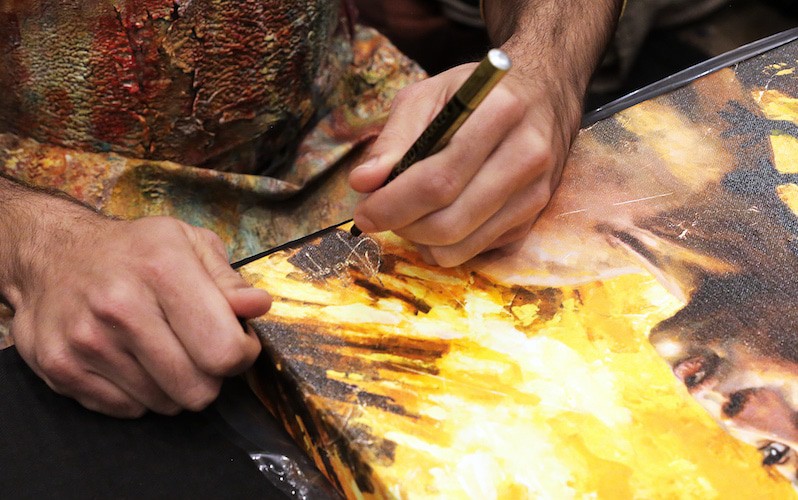
Clark signs a canvas print of “Khaleesi, Mother of Dragons.”
Clark became a self-educated artist by necessity, not by choice. “I would have loved to have gone to a great art school,” he says, “it didn’t really work out for me financially or timing wise.” He had to find his own education. The internet was an invaluable tool—“an endless wealth of knowledge that I took advantage of.” He tracked down books, video lessons, local workshops—any form of instruction he could find. Teaching yourself takes a lot more discipline, he notes, and self-motivation. Sometimes you have to sift through bad content to find the good stuff, but it is there to be found.
When it comes to art, he believes education matters more in the development of skill than many people give it credit for. “There are things about being an artist that you just can’t learn on your own,” he tells me as he embellishes a field in the foreground of a “Cheshire Woods” canvas print with extra red flowers. “Everyone can have really great ideas naturally, but without the technical training those ideas will never realize themselves the way they really are in your head.”
To Clark, a truer conception of the word “talent” would describe it not as a superior baseline ability, but being driven, “a natural love for a craft.” “It helps push you through all the really difficult times when you have to study and you’re not very good and it’s a lot of hard work.”
He also feels there’s a common misconception that “self-taught” is relatively synonymous with not being taught at all, relying on that mythical concept of innate ability that he doesn’t believe in—a misconception that has no relationship to his actual experience. Which is why in discussing his background he always specifically says “self-educated,” emphasizing that in the place of a traditional art school, he built up an education and roster of educators independently through the means available to him.
In his art, he ended up focusing on oils because he finds them the most versatile medium to paint in. In addition to preferring oils for a variety of technical reasons, he appreciates how established it is. “People respect you as an oil painter the most.” He also loves the classical quality of oil painting and feels a particular affinity for 19th-century artists, listing the Impressionists among his favorites—Monet, Renoir, Degas, not so much Cézanne—though he also admires artists representing a number of other movements and styles.
He feels audiences have been drifting away from this classical quality for the past century or so. In addition to serving as the ultimate crossover between his love of fine art and fandom, Clark’s pop culture artwork can be seen as a strategy to restore a broader appreciation for these traditional techniques by applying them to artworks featuring some the most beloved characters and stories of our time.
Based on the ever-present check-out line and the consistent stream of people coming in through the door, it appears to be working.
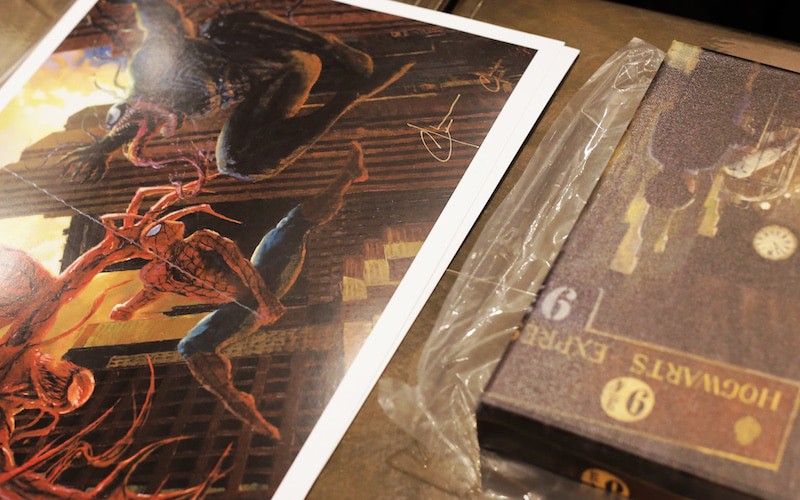
Newly signed prints left to dry
In the first few years of his artistic career, Clark lived by an “I will paint anything for anybody” mentality, enthusiastically snatching up whatever work he could find—couples’ portraits, pet portraits. But as his career has grown and his work has become more in demand, he has had increasing freedom to pick and choose his projects, particularly commissions. “I’m thankful to say I’m busy enough where I can be more picky,” he says.
In fact, Clark is busier than he’s ever been. In addition to four new Alice in Wonderland paintings, he has a commissioned series of musician portraits in the works. He’s due to return to the wizarding world soon because it will have been about a year since he released his last set of Harry Potter paintings. He expects Lucasfilm will be in touch sooner rather than later to inquire about a new Star Wars piece for an exhibit. Come April; he knows he’ll be revisiting Game of Thrones with the release of the hugely anticipated final season.”I’m always playing catch-up,” he admits.
And then, of course, there are events like this one, which take him away from his studio for the better part of a week. He enjoys interacting with other people “who love nerd art the way I do.” That said, he admits that between the travel involved and the nonstop flurry of activity, events like this can be quite exhausting. A day of recovery is usually required when he gets home.
Beyond the work he already has scheduled for the future, there are plenty of pop culture ideas stored away in his brain that he just hasn’t had a chance to make yet. He would like to do a series of ’80s movie posters—”not repainting the movie posters, but doing my own versions.” He’s done one Indiana Jones piece—from Raiders of the Lost Ark—and he would like to do more. He’d like to do a painting of the original Tron film. He also brings up Jim Henson’s Labyrinth and The Princess Bride. He knows if he gets around to making them, they would definitely have an audience—it’s just a matter of finding the time.
In addition to speaking with Clark and The Incredible Art Gallery, I want to hear from the people buying the art, so I start asking around.
I speak with a woman named Kelly. She has four prints in hand—three for her father, a big Game of Thrones fan, and one for herself, a painting of the Hogwarts Express arriving at Platform 9 ¾. She chose it because she works for a company that sells Hogwarts Express trains. She and her family are big-time pop culture art collectors. Art like Clark’s, she says, is appealing because “it’s a classy way to honor your fandom.”
Looking around, that print Kelly chose—“Platform 9 ¾”—appears to be a very popular one. Two college students, Ashley and Lindsey, sit next to a newly embellished canvas print of the same work as they wait for it to dry. Ashley is a big Harry Potter fan. Though being asked to choose a favorite within the series clearly pains her, she ultimately says it’s a tie between Chamber of Secrets and The Goblet of Fire. She actually came to the event the night before but had been unable to make up her mind, ultimately deciding to sleep on it and return the next day.
She’s never purchased art like this before, but she’s going home with a canvas and two paper prints. “I just really appreciated the art. I thought it was amazing, and decided to buy something,” she says. Lindsey tagged along for moral support and encouragement.
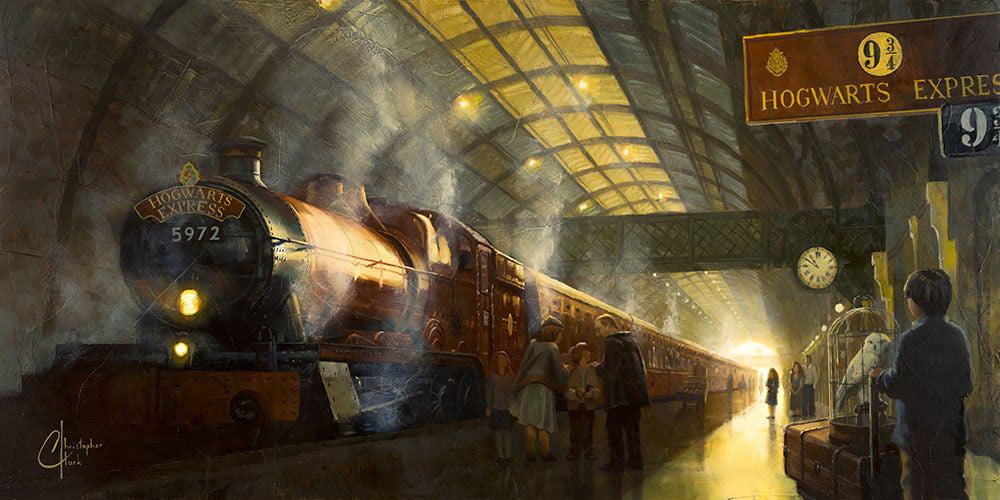
“Platform 9 3/4”
It only takes me a few seconds to find another customer, Chris, with “Platform 9 ¾” in hand. He’s purchasing it as a gift for his wife, a big Harry Potter fan. “When we went to Universal Studios in Florida a couple of years ago we went on the Hogwarts Express, and she was all excited about that, so when I saw this picture, it was like, oh, I think she’d like this,” he says. He also carries several cards featuring a variety of fandoms, “for birthdays”—except for the Batman card. That one he’s getting for himself. The best Batman, in his opinion? “Kevin Conroy,” he answers without a moment’s hesitation. I ask him why he finds pop culture art appealing. “It’s cool to see things expressed in different ways—to see this stuff expressed in different mediums, I think, is really interesting,” he tells me, “it’s a different way to experience it.”
Part of the genius of the art is that even should you manage to find one of the few people on the planet with no knowledge of Harry Potter, they would still look at “Platform 9 ¾” and see a beautiful painting of a train. The other part is that for people who are fans, the image doesn’t just represent a story they love but also frequently has much more specific personal connotations. Some people I ask say they picked a particular work because they thought it was cool and they happen to be a fan of the specific fandom represented, but more often than not their stories run much deeper than that.
Jason, age 11, a self-identified Slytherin, is also getting a print of “Platform 9 ¾”. “It reminded me of the first movie where he first gets on the train and he’s heading to Hogwarts,” he says of his selection. A fan of both the books and the movies, he thinks Harry Potter and the Prisoner of Azkaban is the best installment either way.
I try to think if I have ever before seen an 11-year-old boy looking so happy to be buying artwork and come up empty-handed, but Jason is not the only example of the phenomenon in the room. I speak with Josh, also age 11, and also sorted into Slytherin by the Pottermore quiz, though he would rather be a Gryffindor. He’s here with his father, Chad. Three paper prints spanning Harry Potter, Lord of the Rings, and Star Wars, along with a large Harry Potter canvas, will be his Christmas and birthday presents. Like Jason, Josh says he picked paintings that reminded him of scenes he liked in the movies. “And I like the sunset in this one,” he says of a painting of Hogwarts castle. “It just feels like I’m there when I look at it.”
I end up walking around the event chatting with Clark and a number of visitors for around two hours, far longer than originally intended, for the simple reason that it’s a genuinely enjoyable environment. With all the stories of toxic fandom lately, whether it be angry fans putting together a petition to remove The Last Jedi from the Star Wars canon or harassing actress Kelly Marie Tran to the point that she shut down her Instagram, it’s easy to forget how the fundamental concept of fandom—of people bonding over a shared love of a fictional world and the stories taking place there—is really quite pleasant and wholesome when gatekeeping and other entitled nonsense doesn’t get thrown into the mix.
Fandom can be a beautiful thing. It’s nice to be reminded.
Related Topics: Game of Thrones, Harry Potter, Marvel, Star Wars, The Lord of the Rings


